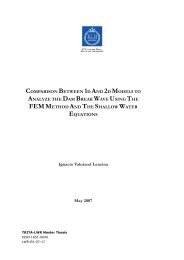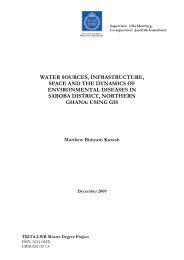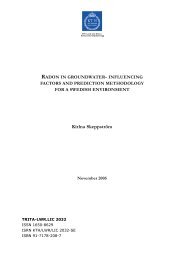POTENTIAL BIOGAS PRODUCTION FROM FISH WASTE AND ...
POTENTIAL BIOGAS PRODUCTION FROM FISH WASTE AND ...
POTENTIAL BIOGAS PRODUCTION FROM FISH WASTE AND ...
Create successful ePaper yourself
Turn your PDF publications into a flip-book with our unique Google optimized e-Paper software.
Potential Biogas Production from Fish Waste and SludgeTable 7 VSR of each small group.SubstratecompositionVS in (%) VS out (%) VSR (%)A1 17.37 1.73 90.04A2 14.64 1.79 87.77A3 14.54 1.74 88.03A4 13.81 1.71 87.62A5 17.30 1.74 89.94B1 17.46 1.80 89.69B2 15.10 1.78 88.21B3 18.58 1.69 90.90B4 18.31 1.86 89.84B5 16.83 1.80 89.304.2.1. The result of Group AIn Group A, the 33 % sludge was mixed with different ratios of codmeat and cod intestine to be digested, and the biogas was produced untilceasing the methanogenesis process. There were two ways to analyze theCH 4 productivity, i.e. based on accumulated CH 4 production (Fig. 12)and daily CH 4 production (Fig. 13).The maximum MP in the Group A after 13 days (Fig 12) was0.533 Nm 3 CH 4/kg VS from A4 which was 45 % cod meat mixed with22 % cod intestines, and the minimum MP came from 67 % cod meatwithout any intestine, only 0.309 Nm 3 CH 4/kg VS.It could be easily observed (Fig. 13) that all the compositions ofsubstrates reached the first peak in the third or fourth days, and thesecond small peak was appeared after 5 or 6 days later. In the 13 th day,the CH 4 productions of most small groups were decreased except A4Fig. 12 Methane potential of Group A (containing 33% sludge) based onaccumulated gas volume.21
















